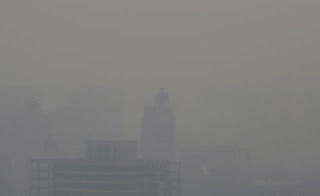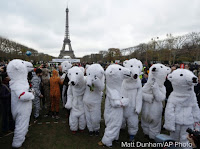Uncertain Health in
an Insecure World – 68
“Reprieve”
Eric Clapton’s I Shot The Sheriff refrain, “One day the bottom will drop out…”, brings
to mind the finality of irrevocable acts.
The World tells us when enough is enough, in its own, none
too subtle ways. Unfortunately, the hardest thing to do, beyond listening, is
to actually hear what it is saying.
The World does not speak our 6,500 languages… any of them.
It talks to us in tongues. We translate with numbers that humans can measure –
vital signs, of a sort – air temperature, sea level, ozone depletion, red
tides, epidemics, droughts and deaths.
During this week’s global climate summit in Paris (COP21),
delegates from 196 countries who have been listening hard for what seems like too
many years (since the Kyoto Protocol of 1997), many of the same people who fumbled at Copenhagen in 2009, finally spoke… as one. Their final agreement on curbing
fossil fuel use is designed to restrain the rise in average global temperature to “well below” +2 degrees Celsius above
pre-industrial levels (or +3.6 degrees Fahrenheit in the one country still
using that scale).
In Obamacare terms, this warming projection is like “bending the curve” of cost expenditures in
order to achieve healthcare system sustainability. As noted by U.S. President
Barack Obama, the Paris plan is “a
turning point for the world… the best chance we have to save the one planet
that we’ve got.”
How does one translate these temperature targets into global
ecosystem terms?
Big data driven predictive analytic models have shown that
between 2050 and 2100, the Paris accord’s limits on greenhouse gas emissions
will achieve a new equilibrium – when trees, soil and oceans can naturally
absorb what human activity is generating. John Schellnhuber of Germany’s Potsdam
Institute for Climate Research calls this positive tipping point “net zero.”
The top greenhouse gas-emitters – China, U.S., EU, India,
Russia, Indonesia, Brazil and Japan – made 2030 pledges to shift from
carbon-intensive fuels in favor of renewable energy sources such as wind and
solar.
Of course, countries can view this multi-trillion dollar
drive to reduce emissions very differently. China, for example, is in the midst
of its own post-industrial revolution. China is also the #1 carbon-based fuel user,
at 2,972 millions of metric tons of oil equivalents, generating 66% of its
energy from coal burning (below).
Beijing, a city of 20 million souls, spent most of
the past week under a red alert due to extremely high particulate level smog.
Widespread industrial coal burning causes poor air quality in China’s cities on
a regular basis, but last week’s levels were an “Airpocalypse.” The handshake with the Devil made by the Chinese
Communist Party in return for breakneck economic growth is paying negative
ecologic returns.
What does the bottom falling out look like?
By the year 2100, the United Nations Intergovernmental Panel
on Climate Change (IPCC, est. 1988) estimates a 20 inch sea level rise. Expert
opinions differ on these numbers – the U.S. National Academy of Sciences (est.
1863) predicts a rise ranging from 16 to 56 inches, depending on how we humans
listen and respond to Earth’s queues. According to scientists and journalists
at Climate Central (est. 2008), including some Weather Channel veterans, this
places some 280 million peoples’ houses at risk of becoming submerged.
The U.S.
Environmental Protection Agency (EPA, est. 1970) says that ocean levels have
already risen 8 inches since Europe’s Industrial Revolution, circa 1870. Pacific
islands like Nauru in the Marshall archipelago (above) and many other vulnerable
countries are threatened right now. Bangladeshi farmers have created floating
agricultural rafts from straw, rice stubble and water hyacinth in response to ever
worsening flooding.
As Unilever CEO, Paul Polman stated from Paris, “This agreement establishes a clear path to
de-carbonize the global economy within the lifetimes of many people alive today.” Outside the boardrooms, protesters in the streets are angered by all the misdirection and obfuscation.
Oddly, the new accord waits until 2020 to take effect,
largely so that individual governments – in some 55 countries representing
at least 55% of global emissions – can ratify and enact the required standards.
The intersection of policy and politics is jobs, and it would be naive to
imagine that economies won’t fail and governments won’t fall in pursuit of
these Paris ideals.
The U.S. Centers for Disease Control and Prevention (CDC,
est. 1946) National Center for Environmental Health has surveyed the scientific
literature on climate change, together with other natural and human-made
stressors http://www.globalchange.gov/engage/activities-products/NCA3/technical-inputs
The threats to human health and promotion of disease are diverse and patently evident
(below), and appear to be intensifying, even in the less extreme North American
ecosystem. New public health problems are to be expected from climate-induced
disruptions of physical, biological and ecological systems.
Guitar aficionados have nick-named Eric Clapton ‘Slowhand’, because he plays complex rock
riffs with such relaxed ease. In his rock classic, The Crossroads, Clapton
sings, “I went down to the crossroads,
fell down on my knees.”
The World is squarely at The Crossroads, right now!
After decades of analytic complexity from scientists and
perilous advocacy by activists, COP21 looked too easy. Those who have brought
Mother Earth to its knees have been handed one final chance… A reprieve.
Many of us standing in the Square today won’t be here in
2050.
But as the seas rise and cities choke, from this day forward, we are all out of envelopes to tear, and others to blame.
But as the seas rise and cities choke, from this day forward, we are all out of envelopes to tear, and others to blame.














No comments:
Post a Comment